
Araucariaceae – also known as araucarians – is a family of coniferous trees, with three living genera, Araucaria, Agathis, and Wollemia. While the family was distributed globally during the Jurassic and Cretaceous periods, in their native distribution they are now largely confined to the Southern Hemisphere, except for a few species of Agathis in Southeast Asia.

Petrified Forest National Park is an American national park in Navajo and Apache counties in northeastern Arizona. Named for its large deposits of petrified wood, the park covers about 346 square miles, encompassing semi-desert shrub steppe as well as highly eroded and colorful badlands. The park's headquarters is about 26 miles (42 km) east of Holbrook along Interstate 40 (I-40), which parallels the BNSF Railway's Southern Transcon, the Puerco River, and historic U.S. Route 66, all crossing the park roughly east–west. The site, the northern part of which extends into the Painted Desert, was declared a national monument in 1906 and a national park in 1962. The park received 644,922 recreational visitors in 2018.

Agathis, commonly known as kauri or dammara, is a genus of evergreen coniferous trees, native to Australasia and Southeast Asia. It is one of three extant genera in the family Araucariaceae, alongside Wollemia and Araucaria. Its leaves are much broader than most conifers. Kauri gum is commercially harvested from New Zealand kauri.

Petrified wood, also known as petrified tree, is the name given to a special type of fossilized wood, the fossilized remains of terrestrial vegetation. Petrifaction is the result of a tree or tree-like plants having been replaced by stone via a mineralization process that often includes permineralization and replacement. The organic materials making up cell walls have been replicated with minerals. In some instances, the original structure of the stem tissue may be partially retained. Unlike other plant fossils, which are typically impressions or compressions, petrified wood is a three-dimensional representation of the original organic material.
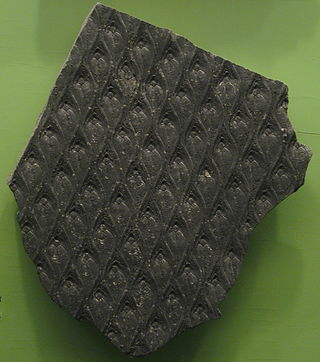
Lepidodendron is an extinct genus of primitive lycopodian vascular plants belonging the order Lepidodendrales. It is well preserved and common in the fossil record. Like other Lepidodendrales, species of Lepidodendron grew as large-tree-like plants in wetland coal forest environments. They sometimes reached heights of 50 metres, and the trunks were often over 1 m (3.3 ft) in diameter. They are often known as "scale trees", due to their bark having been covered in diamond shaped leaf-bases, from which leaves grew during earlier stages of growth. However, they are correctly defined as arborescent lycophytes. They thrived during the Carboniferous Period, and persisted until the end of the Norian around 208 million years ago. Sometimes erroneously called "giant club mosses", the genus was actually more closely related to modern quillworts than to modern club mosses. In the form classification system used in paleobotany, Lepidodendron is both used for the whole plant as well as specifically the stems and leaves.

Araucaria angustifolia, the Paraná pine, Brazilian pine or candelabra tree, is a critically endangered species in the conifer genus Araucaria. Although the common names in various languages refer to the species as a "pine", it does not belong in the genus Pinus.

Fossil wood, also known as fossilized tree, is wood that is preserved in the fossil record. Over time the wood will usually be the part of a plant that is best preserved. Fossil wood may or may not be petrified, in which case it is known as petrified wood or petrified tree. The study of fossil wood is sometimes called palaeoxylology, with a "palaeoxylologist" somebody who studies fossil wood.

The Chinle Formation is an Upper Triassic continental geological formation of fluvial, lacustrine, and palustrine to eolian deposits spread across the U.S. states of Nevada, Utah, northern Arizona, western New Mexico, and western Colorado. In New Mexico, it is often raised to the status of a geological group, the Chinle Group. Some authors have controversially considered the Chinle to be synonymous to the Dockum Group of eastern Colorado and New Mexico, western Texas, the Oklahoma panhandle, and southwestern Kansas. The Chinle Formation is part of the Colorado Plateau, Basin and Range, and the southern section of the Interior Plains. A probable separate depositional basin within the Chinle is found in northwestern Colorado and northeastern Utah. The southern portion of the Chinle reaches a maximum thickness of a little over 520 meters (1,710 ft). Typically, the Chinle rests unconformably on the Moenkopi Formation.

Cheirolepidiaceae is an extinct family of conifers. They first appeared in the Triassic, and were widespread during most of the Mesozoic era. They are united by the possession of a distinctive pollen type assigned to the form genus Classopollis. The name Frenelopsidaceae or "frenelopsids" has been used for a group of Cheirolepidiaceae with jointed stems, thick internode cuticles, sheathing leaf bases and reduced free leaf tips. The leaf morphology has been noted as being similar to that of halophyte Salicornia. Several members of the family appear to have been adapted for semi-arid and coastal settings, with a high tolerance of saline conditions. Cheirolepidiaceae disappeared from most regions of the world during the Cenomanian-Turonian stages of the Late Cretaceous, but reappeared in South America during the Maastrichtian, the final stage of the Cretaceous, increasing in abundance after the K-Pg extinction and being a prominent part of the regional flora during the Paleocene, before going extinct.

An epicormic shoot is a shoot growing from an epicormic bud, which lies underneath the bark of a trunk, stem, or branch of a plant.
The Chinle Formation is an extensive geological unit in the southwestern United States, preserving a very diverse fauna of Late Triassic animals and plants. This is a list of fossilized organisms recovered from the formation.

Araucaria mirabilis is an extinct species of coniferous tree from Patagonia, Argentina. It belongs to the genus Araucaria.
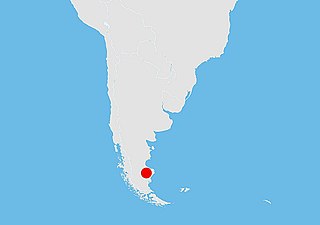
Araucarites sanctaecrucis is an extinct coniferous tree from Patagonia, Argentina. Its exact affinities are unknown and it is currently assigned to the form genus Araucarites of the family Araucariaceae. A. sanctaecrucis are known from petrified fossils of branches, foliage, and cones from the Cerro Cuadrado Petrified Forest.

Agathoxylon is a form genus of fossil wood, including massive tree trunks. Although identified from the late Palaeozoic to the end of the Mesozoic, Agathoxylon is common from the Carboniferous to Triassic. Agathoxylon represents the wood of multiple conifer groups, including both Araucariaceae and Cheirolepidiaceae, with late Paleozoic and Triassic forms possibly representing other conifers or other seed plant groups like "pteridosperms".
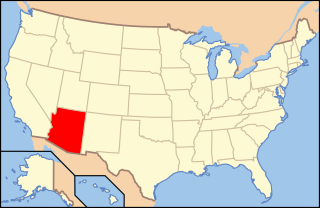
Paleontology in Arizona refers to paleontological research occurring within or conducted by people from the U.S. state of Arizona. The fossil record of Arizona dates to the Precambrian. During the Precambrian, Arizona was home to a shallow sea which was home to jellyfish and stromatolite-forming bacteria. This sea was still in place during the Cambrian period of the Paleozoic era and was home to brachiopods and trilobites, but it withdrew during the Ordovician and Silurian. The sea returned during the Devonian and was home to brachiopods, corals, and fishes. Sea levels began to rise and fall during the Carboniferous, leaving most of the state a richly vegetated coastal plain during the low spells. During the Permian, Arizona was richly vegetated but was submerged by seawater late in the period.

The Shinarump Conglomerate is a geologic formation found in the Four Corners region of the United States. It was deposited in the early part of the Late Triassic period.

The Chemnitz petrified forest is a petrified forest in Chemnitz, Germany, that is part of the Early Permian Leukersdorf Formation.
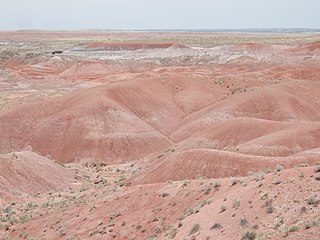
The Petrified Forest Member is a stratigraphic unit of the Chinle Formation in Arizona, Colorado, New Mexico, Nevada, and Utah. It preserves fossils dating back to the Triassic period.

The Jaramillo Petrified Forest National Park is a protected area of petrified forest located in the Deseado Department, in the northeast of Santa Cruz Province, Argentina. Formerly part of the site was a natural monument, established in 1954 and known as the Petrified Forest Natural Monument, covering about 13,700 hectares. This area has remnants of a forest preserved in stone, that had been growing on the site before the upthrust of the Andes some 150 million years ago. In December 2012, further land was added and the protected area was reclassified as a national park with a total area of 78,543 hectares.
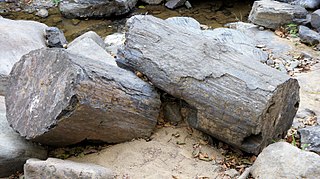
Puyango Petrified Forest is a fossil deposit of petrified wood located in the middle basin of the Puyango River, between the Ecuadorian provinces of El Oro and Loja. The area covers 2,658 hectares and its sediments are divided into four geological formations, dating from the late Cretaceous period. These deposits are rich in both fossilized trunks and leaves - which belonged to the typical Mesozoic flora - as well as fossils of invertebrates such as bivalves, ammonites, echinoderms, among others.





















